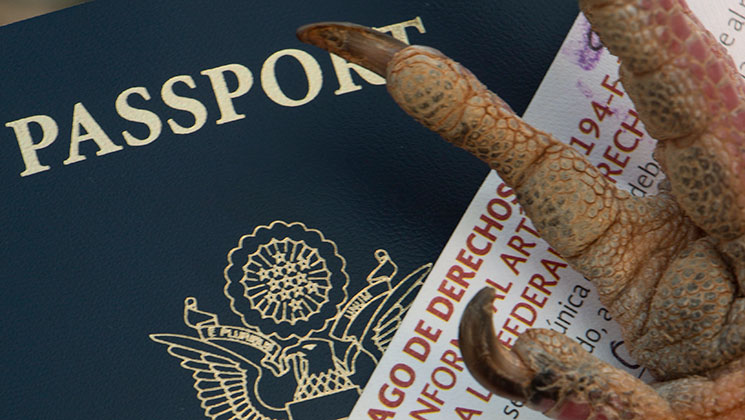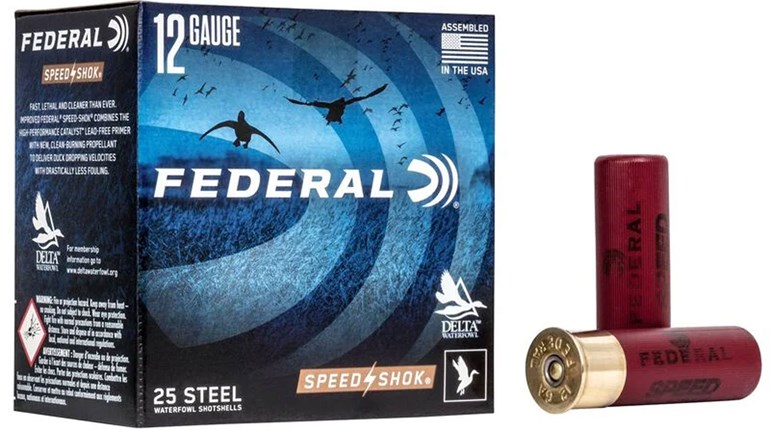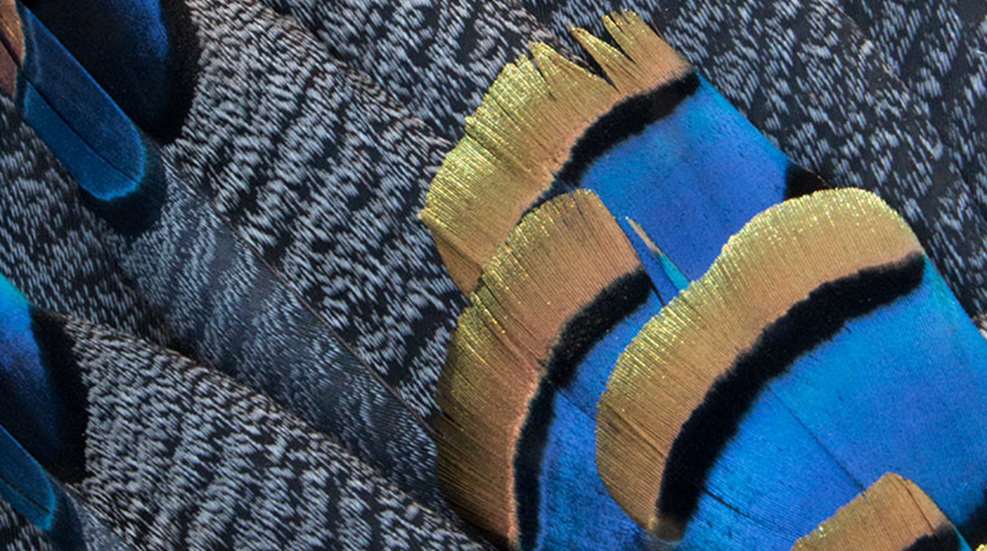
Even those who hunt him for sport at considerable expense and some trouble consider the ocellated turkey an odd bird. Ocellated males can’t be called gobblers because they don’t gobble; they can’t be called longbeards because they don’t have beards. A huge ocellated turkey weighs only about half of what a good Eastern tom will go, and his mating display looks more like a ridiculous squat than an imposing strut. His plumage carries all the colors of a Mardi Gras parade, and his tail feathers bear metallic blue eyespots from which he gets his name (ocellus is Latin for “little eye”). What he lacks in beard, he makes up for in spurs that can approach 2 inches in length.
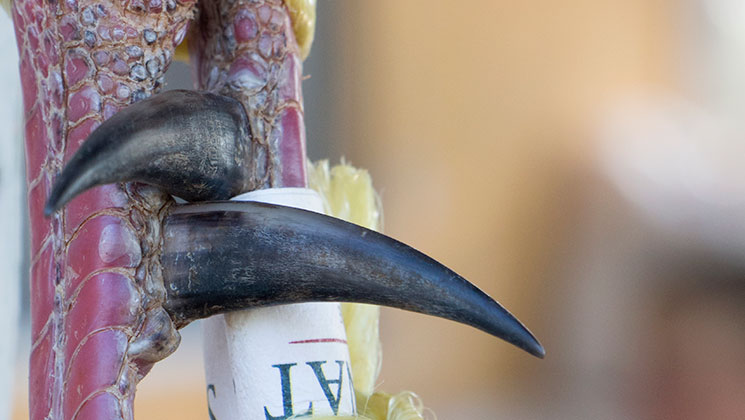
The ocellated is unique among turkeys, and for that he is prized. Meleagris ocellata is a species separate from the more common wild turkey, Meleagris gallopavo. Eastern, Osceola, Rio, Merriam’s and Gould’s turkeys are all gallopavo. Not the ocellated. He stands alone. In fact, some taxonomists argued the ocellated wasn’t a turkey at all and placed him in his own genus, Agriocharis, until a detailed study by David Steadman of the University of Arizona set the record straight in 1980. Today, groups as authoritative as the American Ornithological Society and the National Wild Turkey Federation say the ocellated is indeed a turkey.
He is the only turkey not found in the United States but instead is native to Mexico’s Yucatán Peninsula, and northern Belize and Guatemala. The ocellated lives in the jungle, scratching in the shadows of Mayan ruins with names such as Edzna, Uxmal and Xlapak. Hunting him is as exotic as turkey hunting gets.
Case in point: My guide Harmilo (Air-mee-lo) and I hadn’t made it 50 yards from the truck when we came upon jaguar tracks pressed deep into the red dirt along the edge of the cut maize field. They looked fresh, but my Spanish wasn’t good enough to confirm this with Harmilo. The sound of my Mossberg’s bolt closing on a 12-gauge round bridged the language barrier, though, and he nodded before continuing toward a point of jungle with the blind on his back.
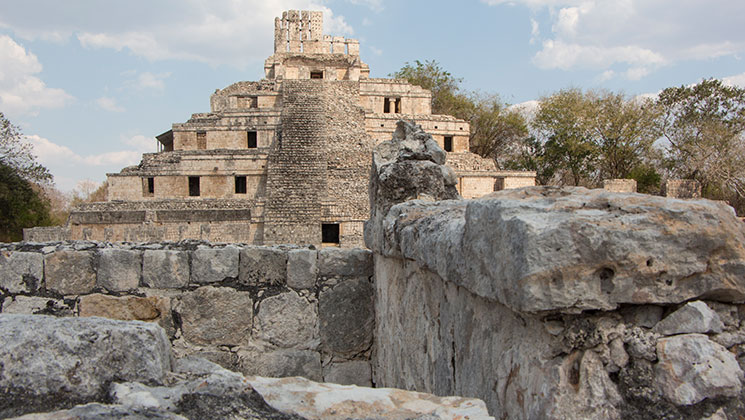
Just as surprising as the jaguar tracks was my guide’s turkey “call”: a battery-powered speaker about the size of a 5-gallon bucket. Into the back of the speaker Harmilo had inserted an SD card that contained a recording of a male ocellated’s breeding song. As he played it, I realized why a more conventional call wouldn’t do. The bird’s song seemed too complicated to replicate with traditional methods. It started with a deep, bass drumming—whump-whump-whump—followed by a series of notes that sounded like a staccato laugh.
After just five minutes in the blind, Harmilo and his speaker produced results. A flock of about 20 birds sailed into the field 200 yards away.
“Pavos,” my guide whispered. Luckily my limited Spanish vocabulary included that word—turkeys. The birds quickly disappeared in the maize, and although Harmilo continued to play the song on la machina, two hours passed until another pavo appeared in the field.
This one was alone, and through the bent stalks of the maize I could see only its head and back. I needed to make sure it was a mature male, but the maize complicated the assessment. While older males have pronounced crests on their heads, and more copper and white on their wings than juveniles, neither characteristic was obvious as the bird moved quickly across the rows, angling in our direction. The only sure way to distinguish sex and gauge age is to look at the spurs, which were impossible to see in the maize.
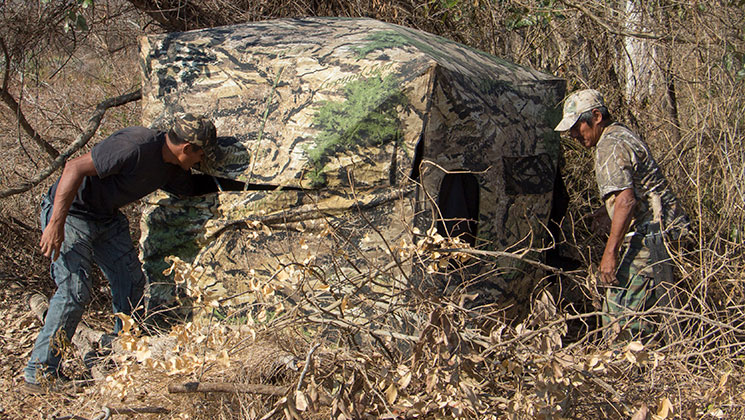
Fortunately there was a strip of lower, sparser vegetation between the maize and the jungle. I could cover about 10 feet of it from my seat in the blind. “Shoot?” I asked Harmilo as the bird stepped into this area, 30 yards or so from the muzzle of my gun.
He hesitated, sizing up the spurs, and then after a couple long seconds, replied, “Si.” But it was too late. The turkey, constantly on the move, had already cleared the strip and was starting to disappear into the brush.
“Sí, shoot,” said my guide. I leaned to the side of the blind window and looked for an opening, but there wasn’t one.
“Shoot, shoot.”
“I can’t,” I said. “Too thick.”
“Shoot!”
Obviously something was lost in translation. Later I learned the guides prefer a stout load of No. 2 shot for these turkeys, despite the relatively small size of the bird. They aim at the body and count on enough big pellets getting through the thick stuff to do the job. Harmilo likely thought I was so equipped, but instead I had a load of No. 7 and was looking for a head/neck shot that never came.
The next morning found us back in the same blind. Just as it was getting light, Harmilo grabbed his speaker and stepped outside. He walked a 30-yard stretch of field edge in front of the blind while playing the song of the pavo. Although in my mind I questioned his stealth, I should have known better than to doubt a local.
Fifteen minutes later a dark, oval-shaped form was standing in the maize 75 yards away. Through my bino I saw the form had a light blue head. Pavo!
Harmilo saw it, too, and pressed the play button on the speaker. The song coming from the box caused the turkey to go into a running half-strut, first to the left then to the right. When my guide played the song again, the pavo abruptly turned 90 degrees and marched straight toward us.
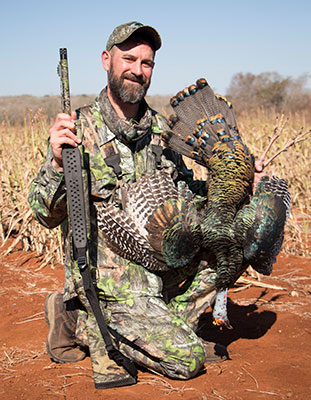 “Shoot, sí,” whispered my guide. When the bird started to angle to the left at 20 yards, this time I had no trouble following Harmilo’s directions.
“Shoot, sí,” whispered my guide. When the bird started to angle to the left at 20 yards, this time I had no trouble following Harmilo’s directions.
Outfitter Jorge Sansores was elated with, but not surprised by, our success when we returned to “camp”—an airy ranch-style house in the tiny settlement of Carlos Cano Cruz—that morning. Jorge, owner of Snook Inn Hunting, has been hunting ocellated turkeys in the Mexican state of Campeche for decades. He is considered a pioneer in both ocellated hunting techniques and conservation.
“These turkeys now respond to calling better than they ever have,” he said as I told him how the bird had made a beeline for Harmilo’s speaker. “The population is increasing a lot, and they are becoming more aggressive to protect their territory.”
When Jorge started hunting ocellated turkeys in the late 1970s, the accepted, traditional tactic was to shoot them off the roost early in the morning. Guides would locate a roost tree in the evening by hearing a turkey singing and sneak hunters into range under the cover of darkness the next morning. The technique traces back to the Yucatán’s Mayan civilization, which used the ocellated turkey as a food source, and is still in practice in some areas of the peninsula. “But not here,” Jorge noted. “We have not had a hunter shoot a bird out of a tree in 15 or 20 years.” That doesn’t mean Jorge and his guides are less successful. In fact, his clients’ success rate on ocellated turkeys is above 95 percent, thanks partly to a growing population of birds.
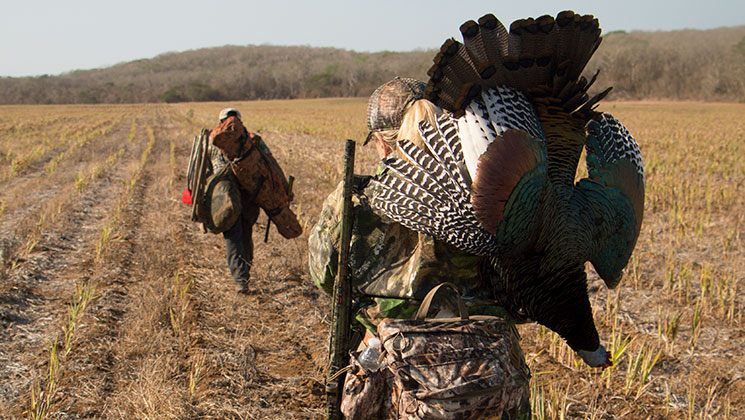
“When we first came here [to Carlos Cano Cruz] to hunt in 1999, a good flock of turkeys had six to eight birds,” he said. “Now, 30 birds in a flock is not a large one. Fifty to 80 birds in one flock with 15 to 20 toms is not unusual. The largest we’ve seen was a flock of 200.” On the 22,000 acres Jorge’s clients hunt, he estimates there are at least 5,000 birds. It’s a success story that ties conservation with community land practices, and demonstrates how hunting can have a direct and positive influence on a local economy. Carlos Cano Cruz is an agricultural community of about 500 inhabitants, located 75 miles southwest of Campeche City. The Mexican government considers it an ejido, a community-based land-ownership system where members of the community are responsible for farming assigned parcels. Much of the land was originally jungle, the natural habitat of the ocellated turkey, but has now been cleared to support crops such as maize and sorghum.
The ocellated is described by the Convention on International Trade in Endangered Species of Wild Fauna and Flora as being in need of international trade controls; habitat changes and local subsistence hunting, particularly in Guatemala, are identified as being the major threats to turkey populations. However, at Carlos Cano Cruz, Jorge has shown local farmers the ocellated turkey can add value to their land through income derived from sport hunting.
“The people here have changed their mentality,” he said. “They now realize a turkey is worth more than a single dinner.”
Conservation efforts at the local level have been so successful at Carlos Cano Cruz that during 2010-2013 Texas Tech graduate student Jon McRoberts used the area for extensive research into the bird’s habits in order to investigate further management strategies. Two of his conclusions: “agricultural production and ocellated turkey management are not mutually exclusive activities and rural stakeholders can maintain an agrarian livelihood while conserving ocellated turkeys” and “turkey populations have flourished as a result of reduced subsistence hunting pressure and strategic harvest.”
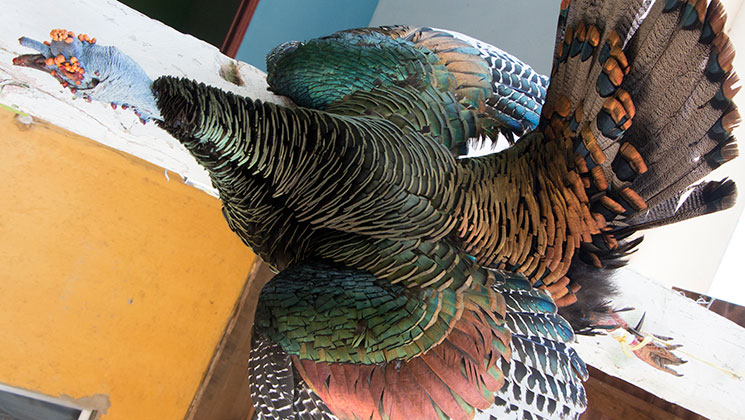
That “strategic harvest” occurs from early February to mid-May, when Jorge and his guides put hunters onto turkeys. Farmers help support hunting in several ways. For one, the grains they grow in their fields have become a preferred food source for the birds, and flocks often congregate in these open areas during the breeding season. In addition, the farmers are constantly working the land and provide Jorge with up-to-date info on sightings, flock sizes and even individual bird characteristics.
Since I was the first hunter in the group to fill a tag, I had several days to hunt with J.J. Reich from Federal Premium and Linda Powell from Mossberg. J.J. and I accompanied a team of guides on a mid-morning mission to set up a blind in a field where a pavo grande had just been spotted. We sat in it that afternoon, and, instigated by J.J.’s guide playing the recorded pavo song, a big ocellated turkey emerged from the jungle as the sun started to set. The bird took his time crossing the field and coming into range, but there was little doubt he was responding to the song. J.J. held it together and dropped the trophy bird, with spurs that measured 1.8 and 1.5 inches, at 25 paces.
The next morning Linda and I were treated to the sounds of el cantor—the “singer,” the local name for a big male turkey—defending his turf against another. The drumming and singing continued behind our blind for the first 90 minutes of light. Linda’s guide played his recording intermittently, and it seemed like the turkeys were responding. It sounded like the birds were moving back and forth behind our hiding spot, much like hung-up turkeys so often do farther north. All had been quiet for half an hour when el cantor suddenly appeared 20 yards from the blind at the edge of the jungle. He sang his last note that morning, but thanks to the efforts of Jorge Sansores and the local farmers, the songs of other ocellated turkeys will continue at Carlos Cano Cruz.
